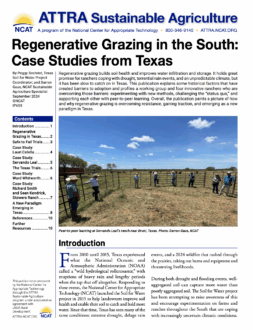A multistate team lead by the National Center for Appropriate Technology developed the following series of rancher profiles as part of a larger project to promote regenerative grazing and soil health throughout the South.
Case Studies from Texas
This publication explains historical factors that have created barriers to adoption and profiles a working group and four innovative ranchers who are overcoming those barriers: experimenting with new methods, challenging the status quo, and supporting each other with peer-to-peer learning. Overall, the publication paints a picture of how and why regenerative grazing is overcoming resistance, gaining traction, and emerging as a new paradigm in Texas.
Case Studies from Arkansas
This publication tells the stories of four innovative Arkansas farm families who are experimenting with new methods, finding ways to overcome obstacles, and connecting with their communities. It also tells the story of mentors and grazing networks that have been supporting each other with peer-to-peer learning for decades. Together, these stories paint a picture of how regenerative grazing is spreading and gaining traction in Arkansas.
Case Studies from Mississippi
This publication tells the stories of four pioneering Mississippi farmers who are trying new practices to enhance soil function and enable their soils to catch and hold more water. These practices are particularly important to resource-limited farmers because they can make farms more resilient and improve community food security. These stories highlight not only successes but also the barriers many farmers in the the South experience in adopting regenerative practices. Together, these stories provide a snapshot of the real-world experience of Mississippi producers, illuminating the importance of networks for providing peer support and illustrating how regenerative grazing is slowly gaining ground with small farmers in Mississippi.
Case Studies from Virginia
This publication tells the stories of five innovative Virginia livestock producers who are experimenting with new methods, finding ways to overcome obstacles, connecting with their communities, and supporting each other with mentorship and peer-to-peer learning. Together, these stories paint a picture of how regenerative grazing is spreading and gaining traction in Virginia.
Want more information? See the related SARE grant:
- Soil for Water (LS21-345)
This material is based upon work that is supported by the National Institute of Food and Agriculture, U.S. Department of Agriculture through the Sustainable Agriculture Research and Education (SARE) program. Any opinions, findings, conclusions, or recommendations expressed in this publication are those of the author(s) and should not be construed to represent any official USDA or U.S. Government determination or policy.
